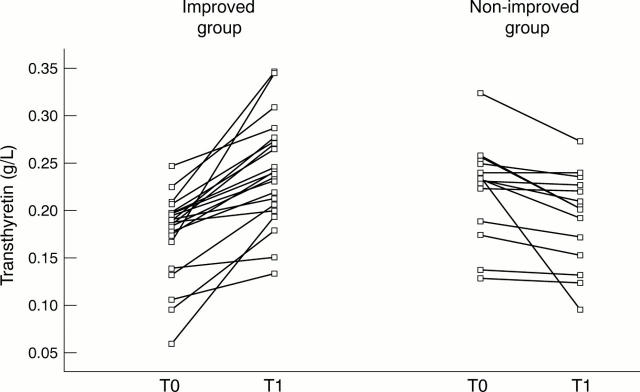Abstract
Aims—To assess changes in indicators of nutrition and iron deficiency as possible non-invasive markers of mucosal recovery in patients with coeliac disease on a gluten free diet.
Methods—Concentrations of transthyretin, retinol binding protein, soluble transferrin receptor, IgA anti-gliadin, and IgA anti-transglutaminase, and titres of IgA anti-endomysial antibody were measured in 36 newly diagnosed adult patients with coeliac disease and duodenal villous atrophy before (T0) and after one year (T1) on a gluten free diet. Duodenal biopsies taken at T0 and T1 were compared and graded as no improvement (no change in initial grade of villous atrophy) or improvement.
Results—Twenty two patients showed histological improvement and 14 showed no improvement. Transthyretin values increased in all patients with mucosal improvement and decreased in all patients showing no improvement. However, transthyretin values did not correlate with the degree of villous atrophy at T0 and T1 when assessed separately. Changes in retinol binding protein and soluble transferrin receptor values did not correlate with mucosal improvement. Coeliac disease associated antibodies (to gliadin, endomysium, and transglutaminase) decreased in most patients between T0 and T1, irrespective of mucosal recovery.
Conclusions—Serial but not single measurements of transthyretin may be used as a non-invasive test to monitor mucosal recovery and therefore reduce the need for, or frequency of, follow up biopsies in treated patients with coeliac disease.
Key Words: coeliac disease • transthyretin • nutrition • villous atrophy
Full Text
The Full Text of this article is available as a PDF (87.5 KB).
Figure 1 Changes in transthyretin values between the time of the initial biopsy (T0) and the repeat biopsy (T1) in the patients with coeliac disease.
Selected References
These references are in PubMed. This may not be the complete list of references from this article.
- Baynes R. D. Assessment of iron status. Clin Biochem. 1996 Jun;29(3):209–215. doi: 10.1016/0009-9120(96)00010-k. [DOI] [PubMed] [Google Scholar]
- Bernstein L. H., Leukhardt-Fairfield C. J., Pleban W., Rudolph R. Usefulness of data on albumin and prealbumin concentrations in determining effectiveness of nutritional support. Clin Chem. 1989 Feb;35(2):271–274. [PubMed] [Google Scholar]
- Dickey W., Hughes D. F., McMillan S. A. Disappearance of endomysial antibodies in treated celiac disease does not indicate histological recovery. Am J Gastroenterol. 2000 Mar;95(3):712–714. doi: 10.1111/j.1572-0241.2000.01838.x. [DOI] [PubMed] [Google Scholar]
- Dickey W., Hughes D. F., McMillan S. A. Reliance on serum endomysial antibody testing underestimates the true prevalence of coeliac disease by one fifth. Scand J Gastroenterol. 2000 Feb;35(2):181–183. doi: 10.1080/003655200750024362. [DOI] [PubMed] [Google Scholar]
- Ferguson B. J., Skikne B. S., Simpson K. M., Baynes R. D., Cook J. D. Serum transferrin receptor distinguishes the anemia of chronic disease from iron deficiency anemia. J Lab Clin Med. 1992 Apr;119(4):385–390. [PubMed] [Google Scholar]
- Haider M., Haider S. Q. Assessment of protein-calorie malnutrition. Clin Chem. 1984 Aug;30(8):1286–1299. [PubMed] [Google Scholar]
- Kuvibidila S., Warrier R. P., Ode D., Yu L. Serum transferrin receptor concentrations in women with mild malnutrition. Am J Clin Nutr. 1996 Apr;63(4):596–601. doi: 10.1093/ajcn/63.4.596. [DOI] [PubMed] [Google Scholar]
- Marsh M. N. Gluten, major histocompatibility complex, and the small intestine. A molecular and immunobiologic approach to the spectrum of gluten sensitivity ('celiac sprue'). Gastroenterology. 1992 Jan;102(1):330–354. [PubMed] [Google Scholar]
- Rask L., Anundi H., Böhme J., Eriksson U., Fredriksson A., Nilsson S. F., Ronne H., Vahlquist A., Peterson P. A. The retinol-binding protein. Scand J Clin Lab Invest Suppl. 1980;154:45–61. [PubMed] [Google Scholar]
- Reifen R., Reif S., Buskila D., Berkovitz Z., Lerner A. Transthyretin: a marker for celiac disease activity. J Med. 1998;29(1-2):30–36. [PubMed] [Google Scholar]
- Rostami K., Kerckhaert J., Tiemessen R., von Blomberg B. M., Meijer J. W., Mulder C. J. Sensitivity of antiendomysium and antigliadin antibodies in untreated celiac disease: disappointing in clinical practice. Am J Gastroenterol. 1999 Apr;94(4):888–894. doi: 10.1111/j.1572-0241.1999.983_f.x. [DOI] [PubMed] [Google Scholar]
- Sategna-Guidetti C., Grosso S., Bruno M., Grosso S. B. Reliability of immunologic markers of celiac sprue in the assessment of mucosal recovery after gluten withdrawal. J Clin Gastroenterol. 1996 Sep;23(2):101–104. doi: 10.1097/00004836-199609000-00006. [DOI] [PubMed] [Google Scholar]
- Skikne B. S., Flowers C. H., Cook J. D. Serum transferrin receptor: a quantitative measure of tissue iron deficiency. Blood. 1990 May 1;75(9):1870–1876. [PubMed] [Google Scholar]
- Uil J. J., van Elburg R. M., van Overbeek F. M., Meyer J. W., Mulder C. J., Heymans H. S. Follow-up of treated coeliac patients: sugar absorption test and intestinal biopsies compared. Eur J Gastroenterol Hepatol. 1996 Mar;8(3):219–223. doi: 10.1097/00042737-199603000-00006. [DOI] [PubMed] [Google Scholar]
- Valentini R. A., Andreani M. L., Corazza G. R., Gasbarrini G. IgA endomysium antibody: a valuable tool in the screening of coeliac disease but not its follow-up. Ital J Gastroenterol. 1994 Jul-Aug;26(6):279–282. [PubMed] [Google Scholar]



